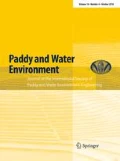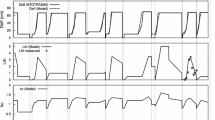Abstract
A new coupled model (PCPF–SWMS) was developed for simulating fate and behavior of pollutant in paddy water and paddy soil. The model coupled the PCPF-1, a lumped model simulating pesticide concentrations in paddy water and 1 cm-surface sediment compartment, and the SWMS-2D, a finite element numerical model solving Richard's and advection-dispersion equations for solute transport in soil compartment. The coupling involved improvements on interactions of the water flow and the concentration the pollutant of at the soil interface between both compartments. The monitoring data collected from experimental plots in Tsukuba, Japan in 1998 and 1999 were used to parameterise and calibrate hydraulic functioning, hydrodynamic and hydrodispersive parameters of the paddy soil. The analysis on the hydraulic functioning of paddy soil revealed that the hard pan layer was the key factor controlling percolation rate and tracer transport. Matric potential and tracer monitoring highlighted the evolution of saturated hydraulic conductivity (K S) of hard pan layer during the crop season. K S slightly decreased after puddling by clay clogging and strongly increased after mid term drainage by drying cracks. The model was able to calculate residential time in every soil layers. Residential time of tracer in top saturated layers was evaluated to be less than 40 days. It took 60 days to reach the unsaturated layers below hardpan layer.








Similar content being viewed by others
References
Adachi K, Sasaki C (1999) Percolation and seepage, In: Miztani M.: Hasegawa S., Koga K., Goto A., Murty V.V.N. (eds) Advanced paddy field engineering. JSIDRE, pp 72–88
Aggarwal GC, Sidhu AS, Sekhon NK, Sandhu KS, Sur HS (1995) Puddling and N management effects on crop response in a rice-wheat cropping system. Soil Till Res 36:129–139
Anbumozhi V, Yamaji E, Tabuchi T (1998) Rice crop growth and yield as influenced by changes in ponding water depth, water regime and fertigation level. Agric Water Manage 37:241–253
Bouman BAM, Wopereis MCS, Kropff MJ, Tenberge HFM, Tuong TP (1994) Water-use efficiency of flooded rice fields .2. Percolation and seepage losses. Agric Water Manage 26:291–304
Carsel RF, Imhoff JC, Hummel PR, Cheplick MJ, Donigian AS (1998) PRZM-3, a model for predicting pesticide and nitrogen fate in the crop root and unsaturated soil zones. Users manual for release 3.0
Chen S-K, Liu CW, Huang H-C (2002) Analysis of water movement in paddy rice fields (II) simulation studies. J Hydrol 268:259–271
Chen S-K, Liu CW (2002) Analysis of water movement in paddy rice fields (I) experimental studies. J Hydrolo 260:206–215
Chowdary VM, Rao NH, Sarma PBS (2004) A coupled soil water and nitrogen balance model for flooded rice fields in India. Agric Ecosyst; Environ 103(3):425–441
Chung SO, Kim HS, Kim JS (2003) Model development for nutrient loading from paddy rice fields. Agric Water Manage 62:1–17
Inao K, Kitamura Y (1999) Pesticide paddy field model (PADDY) for predicting pesticide concentrations in water and soil in paddy fields. Pestic Sci 55:38–46
IRRI (1991) Land use, irrigation, and farm size. World Rice Statistics 1990. Internation Rice Research Institute, Laguna Philippines, pp 201–221
Kibe K, Takahashi M, Kameya T, Urano K (2000) Adsorption equilibriums of principal herbicides on paddy soils in Japan. Sci Environ 263:115–125
Kirby JM, Ringrose-Voase AJ (2000) Drying of some Philippine and Indonesian puddled rice soils following surface drainage: numerical analysis using a swelling soil flow model. Soil Till Res 57:13–30
Klute A (1986) Methods of Soil Analysis. In: Klute A (ed)
Kukal SS, Aggarwal GC (2003) Puddling depth and intensity effects in rice-wheat system on a sandy loam soil I. Development of subsurface compaction. Soil Till Res 72:1–8
Lin HC, Richards DR, Yeh GT, Cheng JR, Cheng HP, Jones NL (1996) FEMWATER: a three-dimensional finite element computer model for simulating density dependent flow and transport. Tech Rep
Liu CW, Chen SK, Jou SW, Kuo SF (2001) Estimation of the infiltration rate of a paddy field in Yun-Lin, Taiwan. Agric Syst 68:41–54
Liu CW, Chen SK, Jang CS (2004) Modelling water infiltration in cracked paddy field soil. Hydrol Processes 18:2503–2513
Miao ZW, Cheplick MJ, Williams MW, Trevisan M, Padovani L, Gennari M, Ferrero A, Vidotto F, Capri E (2003) Simulating pesticide leaching and runoff in rice paddies with the RICEWQ-VADOFT model. J Environ Qual 32:2189–2199
Mohanty M, Painuli DK, Mandal KG (2004) Effect of puddling intensity on temporal variation in soil physical conditions and yield of rice (Oryza sativa L.) in a Vertisol of central India. Soil Till Res 76:83–94
Mualem Y (1978) Hydraulic conductivity of unsaturated porous media: generalized macroscopic approach. Water Resour Res 14:325–334
Nanzyo M, Shoji S, Dahlgren R (1993) Physical characterictics of volcanic ash soils, In: Development in soil science, vol 21, Volcanic ash soils genesis, Properties and utilization. Elsevier, Amsterdam, pp 189–208
Sharma PK, De Datta SK (1985) Effects of puddling on soil physical properties and processes. In: IRRI (ed) Soil physics and rice, Los Banos, Philippines, pp 217–234
Simunek J, Vogel T, van Genuchten MTh (1994) The SWMS_2D Code for simulating water flow and solute transport in tow dimensional variably saturated media (Version 1.21). Research Report No. 132. US Salinity Laboratory Agricultural Research Service, US Department of Agriculture, Riverside, California
Simunek J, Sejna MT, van Genuchten M (1999) The Hydrus-2D Software Package for Simulating the Two-dimensional Movement of Water, Heat, and Multiple Solutes in Variably Saturated Medai, Version 2.0. IGWMC-TPS-70, International Ground Water Modeling Center, Colorado School of Mines, Golden Colorado
Singh KB, Gajri PR, Arora VK (2001) Modelling the effects of soil and water management practices on the water balance and performance of rice. Agric Water Manage 49:77–95
Tuong TP, Wopereis MCS, Marquez JA, Kropff MJ (1994) Mechanisms and control of percolation losses in irrigated puddled rice fields. Soil Sci Soc Am J 58:1794–1803
van Genuchten M (1980) A closed-form equation for predicting the hydraulic properties of unsaturated soils. Soil Sci Soc Am J 49:1093–1099
van Genuchten M, Leij FJ, Yates SR (1991) The RETC code for quantifying hydraulic functions of unsaturated soils. US Salinity Laboratory, US Department of Agriculture, ARS, Riverside
Vu SH, Watanabe H, Takagi K (2005) Application of FAO-56 for evaluating evapotranspiration in simulation of pollutant runoff from paddy rice field in Japan. Agric Water Manage 76(3):195–210
Watanabe H, Takagi K (2000a) A simulation model for predicting pesticide concentrations in paddy water and surface soil. I. Model development. Environ Technol 21:1379–1391
Watanabe H, Takagi K (2000b) A simulation model for predicting pesticide concentrations in paddy water and surface soil II. Model validation and application. Environ Technol 21:1393–1404
Watanabe H, Takagi K, Vu SH (2005a) Simulation of mefenacet concentrations in paddy field by improved PCPF-1 model. Pest Manage Sci (in press)
Watanabe H, Vu SH, Tournebize J, Nguyen MHT, Komany S, Phong TK, Hien TQ, Ishihara S, Takagi K (2005b) Monitoring and Modeling of Pesticide Fate and Transport in Paddy Fields; Challenges for Reducing Environmental Risk. Proceedings of the 2nd International Conference of Japan Korea Research Cooperation, Impact Assessment of Farm Chemicals Runoff from Paddy Field and Biodiversity Conservation. March 16, 2005. Tsukuba, Japan. pp 69–82
Williams MW, Ritter AM, Cheplick MJ, Zdinak CE (1999) RICEWQ: Pesticide runoff model for rice crops. Users manual and program documentation. Version 1.6.1
Wopereis MCS, Bouman BAM, Kropff MJ, Tenberge HFM, Maligaya AR (1994) Water-use efficiency of flooded rice fields .1. Validation of the soil-water balance model sawah. Agric Water Manage 26:277–289
Acknowledgements
The authors thank different institutions Tokyo University of Agriculture and Technology, National Institute for Agro-Environmental Sciences of Japan and Cemagref of France for their benevolence. This research was funded by the Innovative Technology Research Project in the Ministry of Agriculture, Forestry and Fisheries and partially supported by a Domestic Research Fellowship from Japan Science Technology Corporation and JAPAN- FRANCE integrated action program SAKURA by the Japan Society for the Promotion of Science (JSPS, number 1522) and the Ministere des Affaires Etrangères in France (MAE number 06986). The authors thank the reviewers and Dr Manon Janssen for their comments.
Author information
Authors and Affiliations
Corresponding author
Rights and permissions
About this article
Cite this article
Tournebize, J., Watanabe, H., Takagi, K. et al. The development of a coupled model (PCPF-SWMS) to simulate water flow and pollutant transport in Japanese paddy fields. Paddy Water Environ 4, 39–51 (2006). https://doi.org/10.1007/s10333-005-0028-0
Received:
Accepted:
Published:
Issue Date:
DOI: https://doi.org/10.1007/s10333-005-0028-0




